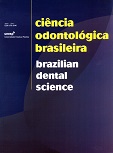Fatores de risco a cárie e CPOD em crianças com idade escolar
DOI:
https://doi.org/10.14295/bds.2004.v7i2.491Abstract
Para estabelecer o risco de cárie, dados clínicos e microbiológicos, bem como nível sócio econômico e hábitosde higiene bucal devem ser considerados. O objetivo do presente estudo foi avaliar fatores de risco de cárie emescolares de nível sócio – econômico baixo e acesso limitado a cuidados odontológicos. Neste estudo foramincluídas 211 crianças de seis a 11 anos de idade. O CPO-D foi avaliado por um único examinador previamentecalibrado, de acordo com os critérios propostos pela Organização Mundial de Saúde. Amostras de saliva foramobtidas pelo método proposto por Kölher & Bratthal (1979), para quantificar estreptococos do tipo mutans. Orisco de cárie foi classificado para cada indivíduo em baixo, intermediário ou alto. Os valores médios encontradosna população foram de 5,1 para o CPO-D e de 2,3 para o número médio de escovações diárias. Não foirelatado uso de fio dental por nenhum participante do estudo. De acordo com os dados microbiológicos, 165crianças apresentaram baixo risco de cárie (CPO-D = 4,9) e 46 risco intermediário (CPO-D = 6). ANOVA e Testede permutação demonstraram correlação positiva entre CPO-D e S. mutans (p < 0.05). De acordo com os resultadosos autores concluíram que houve um CPO-D elevado na população e relacionados à fatores de risco decárie, incluindo, contagem de S. mutans, hábitos de higiene bucal e acesso limitado a cuidados odontológicos.Downloads
Downloads
Published
How to Cite
Issue
Section
License
Brazilian Dental Science uses the Creative Commons (CC-BY 4.0) license, thus preserving the integrity of articles in an open access environment. The journal allows the author to retain publishing rights without restrictions.
=================




























